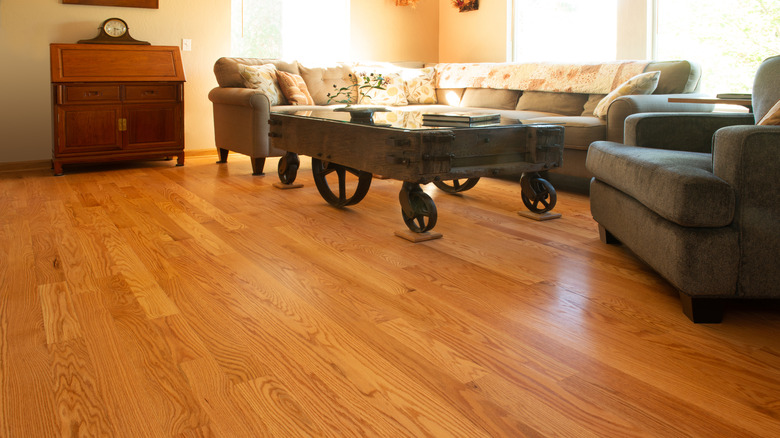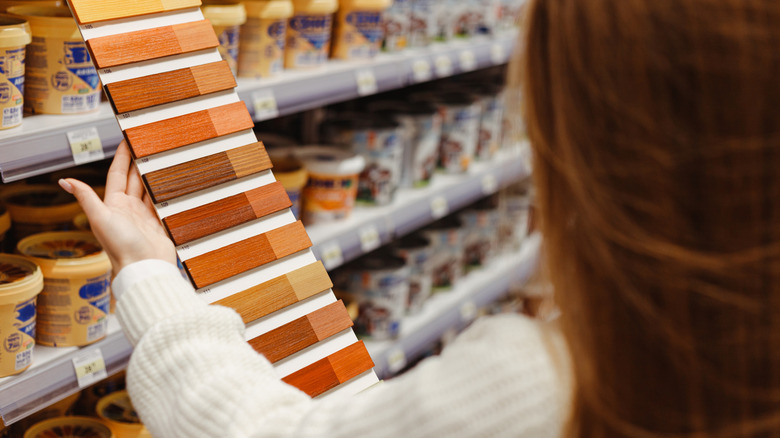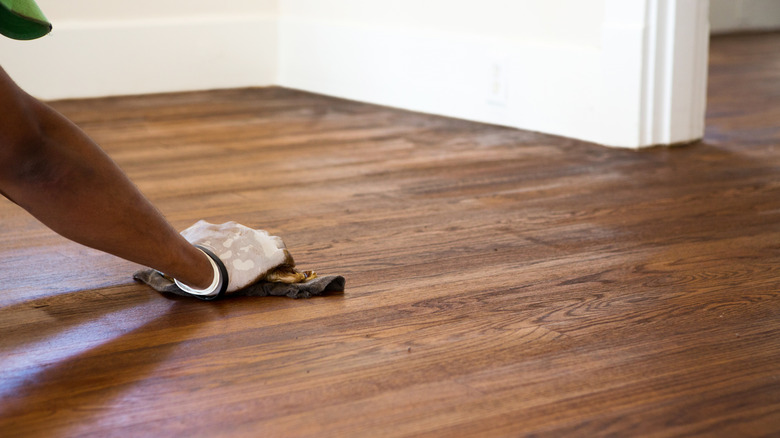How To Choose The Perfect Stain For Natural Red Oak Floors
As grey floors go out of style, and 2025's best floor stain colors to choose from feature warmer honey and teak tones, you should consider yourself lucky if you have natural red oak floors. One of the most popular flooring options, red oak is affordable and durable. Despite its distinctive grain pattern, it's also surprisingly easy to sand and finish yourself, making red oak flooring an ideal choice for DIY refinishing. According to Brett Miller, Vice President of Technical Education & Certification at the National Wood Flooring Association, because of its inherent undertones, there are some important things to consider before choosing the perfect stain for your natural red oak floors.
"When staining a red oak floor, it is important to consider complementary tones within the space," Miller told House Digest during his exclusive interview. "The floor is likely going to be the focal point of the space, and usually sets the tone for paint, furniture, fabric, and other woodwork colors," he said. "When the red undertone of red oak becomes a concern, a professional flooring finisher can incorporate products that can minimize the red," the flooring expert told us. You'll need to go back to basic color theory, cancelling out red by visiting the opposite side of the color wheel: green. "Adding a slight amount of green tint to a sealer, or going with a stain that has green undertones, will negate most of the red that naturally occurs in red oak," Miller explained. If you want to get rid of the red, he says to look for finishes that contain red-reducing pre-tone products or reactive conditioners.
Choose a color with earthy undertones for a natural look
Easy to clean and hard to beat in terms of return on investment, there are many reasons hardwood floors will always be the right choice for a home. Oak is a timeless option. But if you're planning on installing new floors or refinishing existing ones, it's important to get the color right. "Wood flooring is trending toward natural colors," Miller told House Digest during his exclusive interview. "Over the last 10 years, trends have gone from dark browns, to blacks and greys, to whites, and now back to natural," he added. The flooring expert went on to suggest that you select stains with undertones that look earthy, which are often ones that lean toward tan or beige. "The perfect color is one that showcases the natural beauty of the real wood, while complementing the home itself," Miller emphasized.
The shift in wood tones is motivated by an overall desire by many consumers to incorporate a more natural look in their home decor. "These colors bring out the natural characteristics in the wood," Miller explained. "Many of these natural color tones actually highlight the wood, bringing a warmth to the space," he continued. The expert said the desire for natural products spans across all floor covering purchases, which may explain the perpetual popularity of rugs made from wool, jute, and sisal, in addition to hardwood floors themselves. According to Miller, "The biophilia design trends have hit the design industry heavy over the last few years, which is where real wood flooring plays a critical role in this trend."
Remember to test your floor stain color before committing
After spending days, weeks, or even months choosing the perfect stain color, you may be wondering how much time it should take to actually refinish your hardwood floors. The process isn't hard, per se, but the answer depends on how much flooring you need to stain as well as its overall condition. Before you get started, there's one important step you must do: test your stain color.
In his exclusive interview with House Digest, Miller said it's a step you shouldn't skip. "Most professional flooring contractors will lay stain samples out on the floor," he explained. Miller said there are two major benefits to testing in your space. "It allows the customer to see how the color options look on the wood it will be applied to ... and since color can be greatly affected by the type of lighting in the room, it is always important to view the color under the actual lighting," he explained. The flooring expert cautioned that you shouldn't test too many colors so you don't get overwhelmed. "Less is more," Miller emphasized. "Use the flooring professional's suggestions to get an idea of how the floor color will be affected by furniture, wall paint, other woodwork, lighting, etc.," he suggested. Starting with three to five color options is a good idea, he added, explaining that it will give you a good starting point without causing decision paralysis.


